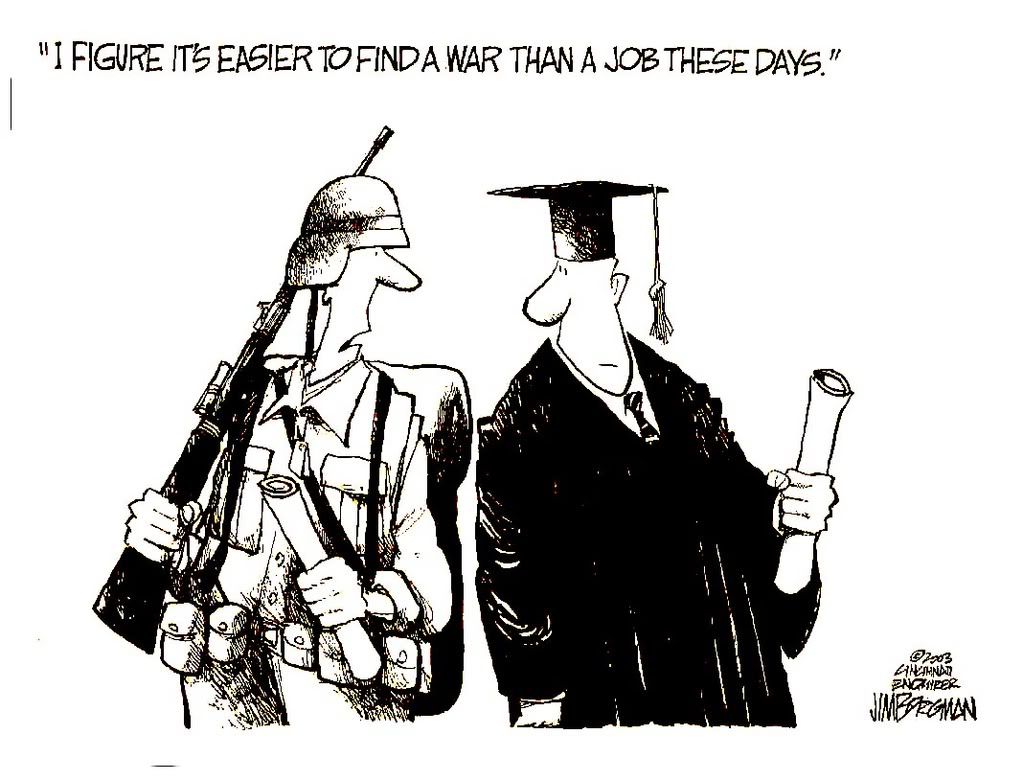
This is just one of Jim Borgman's thousands of political cartoons. A cartoonist who has been honored with many awards ranging from small contest winnings to the 1991 Pulitzer Prize. With wide-ranging talent such as his, it is unique that one particular cartoon stuck out. However, this cartoon titled "Get a Job" contains so much politcal and rhetorical value in such a small, simple drawing. Through the rhetorical strategies of analogy and compare and contrast, Borgman develops and expands upon various appeals, particularly pathos through irony.
Borgman makes a strong set of statements about the current dilemmas facing our nation and within these statements there are strong rhetorical appeals. The dialogue that is taking place between the soldier and the young graduate, "I figure it's easier to find a war than a job these days," alludes particularly to the problems of a younger generation of Americans.
It is important to understand what this problem is before continuing to address the rhetorical appeals that are being demonstrated. The spitting image of a young serviceman on the left, complete with flack jacket and gunny sack stands ready to walk to his right. On the other side of the cartoon a gown-covered graduate who most likely just walked off the stage from a state university graduation stands listening to the cadet's words. While they are both facing each other and are taking note of and paying attention to each other they are indeed prepared to walk in separate directions. These separate paths of life represent the choice that many American teen-aged youth are being forced to make. With difficulty in securing a job in the ever-changing, disordered workplace of corporate America that exists today Borgman boldly suggests that perhaps some youth are realizing that service to the nation provides a more solidified career path.
However, there are undoubtedly rhetorical appeals within this cartoon. Mr. Borgman's selection of dialogue suggests that his stance on this issue is arguing in favor of the military as an alternate career path when compared against the "norm" of getting a college degree and entering the workforce to earn one's keep. By viewing this piece of media objectively the term photo manipulation jumps out. Of course Borgman manipulated the piece of paper that he drew this on, if he did not do that we would be viewing a blank sheet. However, the point remains that the image has been modified to serve the purpose of the artist and not to directly portray what is happening in real life.
As Jim Borgman is the artist or author of this cartoon we as an audience are free to make our own decisions about his portrayal of the situation that is presented within the cartoon. Artistically, the arrangement of the images are important to the development of the cartoon. The images are placed side by side, paralleling each other and facing the audience. However, his appeals of rhetoric are made based on a combination of his thoughts and with the audience in mind.

Borgman did not invent any of the ideas within his cartoon, and as such he can't claim his creativity to be responsible for the characters. Even though he didn't directly create the army soldier or college graduate he did arrange them in a unique style to express his ideas in unique ways. For instance take the paper that each one of them is holding. At a glance they appear to be nothing more than a sheet of paper. But after thinking for a while ideas begin to develop. It would make sense that the paper the soldier holds either his enlistment paper or his deployment. Contrary to this the tassel-capped graduate is most likely holding his diploma although it could be a résumé given that the discussion topic is about jobs. This contrast and comparison is put to good use for Borgman's argument by showing that a deployment is equal to or better than a diploma. One could compare them both and say that perhaps they are both holding diplomas. While one person seeks to live a life through the economy and avoid the imperialism of war, the other desires to avoid the economic recession and partake in militaristic campaigns. Other visual comparisons lie in the similarities formulated between a graduation cap complete with tassle and a military helmet as well as graduation gown and combat fatigues. Further examination reveals that the uniforms are very important to the analogy of this cartoon.
The best rhetorical device that is used in this cartoon is an analogy. Two objects or ideas that are typically regarded as being different in many aspects are made to appear similar in an analogy. Borgman does this perfectly by making a graduate comprable to a soldier, which normally are two completely different career types that people select. However, realizing that they are both people Borgman continues to search through the characters and pull out similarities until he comes up with the notion that a soldier has a much easier time finding an outlet for his abilities than a college student. One way of writing out this analogy would be to say that a soldier is a potential worker in the same way that a college graduate is a potential worker. However, the importance of comparing the similarities goes beyond jobs. The idea that both of them have a degree, or one has a degree and another has deployment orders is an important analogy. Perhaps with the unique society that is America, an individual is free to engage in economic or militaristic careers. Depending upon the current state of affairs, either could be a viable means of living.
This analysis of rhetorical strategies leads into rhetorical appeals that Borgman utilizes within this particular work. Within this one cartoon logos, pathos, and ethos can all be found in use. These appeals all represent persuasion either separately or used in unison. "Passionate logic", "good-willed pathos" and "logical ethos" are all means to achieve various effects. Rational, emotional and authoritative statements can be derived logically from an examination of the scene presented within Borgman's cartoon. While the ethos comes from unseen elements of the cartoon, such as the fact that Borgman has drawn thousands of cartoons as an editorial columnist for almost 30 years. The appeal to pathos is made as an overarching effect with the intent of being humorous and ironical. The whole situation is ironical because for a long period of time the traditional norm has been to graduate from college and inter the workforce. Whereas entering the military to serve one's country was widespread and viewed as an honor during previous times of war, it is viewed as being a controversial topic now. Borgman utilizes the thousands of varying perspectives on this topic to make the situation in the cartoon ironic and comical instead of intensely narrow-minded and bigoted.
As far as political cartoons go they are a genre that carefully tread the line between rhetoric and propaganda. However this particular cartoon can not be accused of doing so, seeing as how there is no direct use of stacking the evidence as in propaganda. Both sides of the issue are portrayed in a manner concerning logos but neither are directly affected by pure logic. That is to say that the soldier and the student are presented in a logical ways both with the image and the text. The appeal to logos can be stretched to say that it is presented in a cause and effect manner. Borgman shows that the war has caused the effect of a higher demand of soldiers than career professionals.
The greatest appeal made is to pathos. By presenting the idea as a cartoon the audience is less likely to feel pressured by ideas or opinions. The mood is joking and friendly and within this mood, Borgman's ideas are presented clearly. While the emotions that are evoked could be strong and passionate, the typical emotions of pathos, this is not necessarily so within this image. Rather than stirring up new emotions and strengthening them Borgman plays on opinions about war, education and the job economy that people already possess.
All things considered within this cartoon, Jim Borgman shows why he is a winner of multiple awards and is one of the top political column cartoonists. His appeals are varying and clearly developed within the scope of a single frame. By playing strongly on opinions, emotions and irony, an excellent rhetorical device is created.
